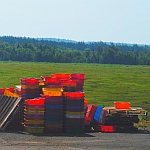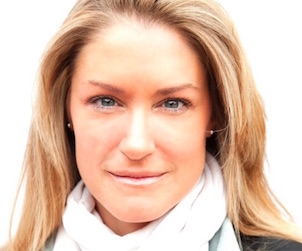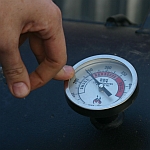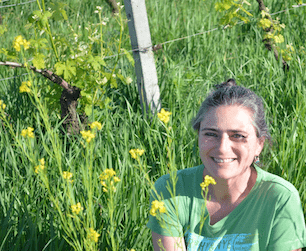by Malcolm Jolley
This is the second of a two part series on wild blueberry harvest in Nova Scotia, which I witnessed at the end of August, 2010. In Part 1, I describe how wild blueberries are ‘farmed’. In Part 2, I look at how the wild blueberries are processed, since 90% of the crop is frozen.
Curtis Millen is a famous farmer in Colchester County, Nova Scotia and beyond. His fruit and vegetables are sold locally and across the province and he even ‘exports’ some of his wild blueberries to Ontario. Peter Rideout, who was my guide, along with Neri Vautour from the Wild Blueberry Association of North America (on whose invitation I came to watch the harvest), explained in the car ride over to Millen’s farm near Masstown that the farmer had a reputation as a self-made man. As a kid, Millen had got a job helping out a local farmer. The farmer saw something in his young farmhand, and gave him a few rows of his field to tend on his own, understanding his payment would be whatever he could get out of them. The rest is history, but Millen continues to try and get the most out of his rows. One way he does this is to process his own wild blueberries. The lion’s share of the wild blueberry crop, which is grown commercially in Maine, Nova Scotia, New Brunswick, P.E.I. and parts of Quebec and Newfoundland is processed by large companies, particularly Oxford Frozen Foods. Bigger companies like Oxford, which was founded by local blueberry farmer turned industrialist, John Bragg, have the capacity to ship across the country and beyond to lucrative export markets like Germany and Japan. But Millen prefers to do things his way, and built a make-shift plant on his farm and handles the orders himself.
Millen’s operation was one of three I saw over two days, and the most hands-on. He uses mostly seasonal workers, women from Jamaica, who he flies in and boards to clean, sort and box his berries as they come off his fields. Millen does not have the capacity to freeze his berries or keep them in cold storage – both processes would require expensive capital outlay, and blueberries constitute only one of his farms’ crops. Instead, he sends them to Halifax, from whence they are distributed t his customers throughout the year.
The second operation we visited was Rainbow Farms, which Rideout and Vautour described as in the middle of the blueberry processing scale. Rainbow’s capacity was clearly bigger than Millen’s, as evidenced by the stacks of empty plastic trays used to collect the berries from the fields. Stepping inside of the large tin-sided factory-like shed, I was met with a fruity, winery smell. Barbara Hegell runs Rainbow, which was started by her father Ronald, who everyone calls ‘Bud’. Rainbow’s growth into one of the region’s biggest independent processors was organic. They began as farmers and decided vertically integrate and get into processing. As they looked for ways to improve their processing methods, they became more productive and began to source more fruit, buying more land and working with other farmers. Their plant, roughly the size of a football field, was far more automated than Millen’s, and so less staffed. The machines in the plant were mostly designed or adapted by Bud Hegell. Because wild blueberry farming and processing is unique to the Maritime area, much of the technology is homegrown. Likewise, Hegell has been buying up woodlots surrounding the plant, clearing them and letting wild blueberries grow – her operation is the epitome of local in an industry that is already extremely regional. She knows all the growers and workers, and they know her.
The third plant we visited was in Oxford, Nova Scotia, owned and operated by the frozen foods company of the same name. I wish I could describe in detail the amazing things I saw in their sprawling facility, which is not only certified by every imaginable health and food safety body but is also, because of the cross-border nature of their business, approved by the US Homeland Security Agency. I wish I could, but I can’t because I signed a non-disclosure agreement, which limits me from detailed descriptions. I think I am okay, though, to say that I witnessed just about every technological possibility in the plant, and however they do it, Oxford is very good at executing on the fundamentals of wild blueberry processing.
The process of packaging blueberries is pretty much the same no matter what the scale. There are three things that must happen: 1) the berries must be cleaned, 2) they must be sorted by size and physical condition and 3) the amount of time between picking and freezing must be as small as possible. Once they are frozen and sitting in a warehouse below zero, the pressure is off. But the job of getting them from field to box can be a bit of a logistical nightmare. Oxford CEO John Hoffman, and founder and Chariman John Bragg, agreed on this last point. The other journalists on the tour and I met them in a boardroom, prior to our visit t the plant. The problem Bragg explained is that if all the blueberries are ready to be harvested at the same time, there may not be capacity on the plant. Hoffman went on to stress that Oxford was adamant that their frozen blueberries had to be “fresher than fresh”, by which he meant that berries on the grocery store shelf would be a few days old and begun to turn, whereas their frozen ones would have been picked and frozen on the same day. Staggering the harvest is important, but it’s also risky. During our visit the weather was hot and sunny, and some of the wild blueberries in the fields we visited were shriveling up. The forecast for the days at the end of the week were worse: Hurricane Earl! At the same time, I recalled Barbara Hegell talking about “trucks lined-up” at Rainbow farms on our earlier visit, and I understood what she meant. Even in a “reefer” (a refrigerated 18-wheeler), once picked the blueberries would lose freshness and start to get soft. Then, they’d burst and less and less of them would ‘make the grade’. Hoffman explained that Oxford solution to this was their vertical integration: by managing the fields they could closely monitor and (hopefully) predict which berries could be picked when. In the worse case scenario, they’d hold off on their own fields and pick the fields of their suppliers first. In any event, blueberry processing is a race and every effort is made to make the journey from field t freezer as quick as possible.
“Or Japanese clients tell us we have the cleanest fruit product they deal with,” John Bragg said, adding, “and that includes other imports like oranges and bananas.” What makes it more remarkable, David Hoffman explained is that, “wild blueberries are about the dirtiest fruit there is when they come into the plant.” What Oxford, Rainbow and Millen all had in common was an extensive cleaning process. Wild blueberries only stand a few inches of the ground. They are grazed on by bears and other wildlife that leave their droppings. They are grown on wild fields where other berries and small plants also grow, never mind the bugs that crawl around. And they are a scrubby little bush full of little twigs and small spearhead shaped leaves. A lot of things other than berries come into the processing plants. What impressed me most about all the operations was how the berries were cleaned: with water. The process was incredibly natural using water, blown air and a water solution with an edible, safe and natural substance like sugar. For all the mechanized whirr of the plants, the machines were doing nothing more sinister than what you’d do if you picked a pint of berries, washed them out in your sink, let them dry and popped them in your freezer. No chemicals, no preservatives: the ingredient list is one word long.
The fresh foraged wild blueberries from Northern Ontario for sale at my local boutique are $9.99 for a pint. That’s a lot of money, especially if you needed to buy a lot to make pies for a bakery, for instance. And they’re only available for a month or two at most. The berries from Millen, Rainbow or Oxford are cheap, clean, safe and available all year round. What other processed food can make this claim? They are also definitively from a place: true product of Canada. In this sense I think each of the processors I visited exemplify a way of producing food that marries the industrial impulse for scale with the artisanal impulse for purity, authenticity and food security. Millen demonstrates mixed farming and independent production. Rainbow Farms demonstrates independent innovation and application of technology. Oxford’s operations shows that large scale food production can be done naturally and nutritionally without additives: that it’s possible to scale up real food. I hope there are more stories ike this out there.
 Malcolm Jolley is the Managing Editor of Good Food Revolution and Executive Director of Good Food Media, the non-profit organization that publishes GFR. Follow him at twitter.com/malcolmjolley.
Malcolm Jolley is the Managing Editor of Good Food Revolution and Executive Director of Good Food Media, the non-profit organization that publishes GFR. Follow him at twitter.com/malcolmjolley.









Hello,
We have been requested for cooperation by a Korean distributing company in terms of importing processed blueberry from Canada.
It would be greatly appreciated if you could assist us in contacting Canadian suppliers of processed blueberry who are exporting or selling good quality at cheaper prices.
Kind regards,
Young
Young K. Kim (Mr.)
President / Korean Society of Metro Windsor